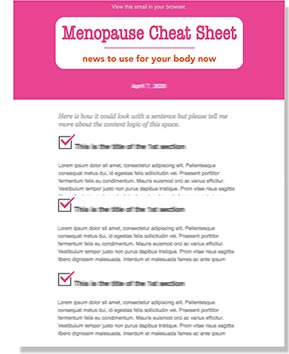
Before you even think about embarking on any of them, consider this fundamental truth: you can’t move forward if you’re stuck where you are.
By the time we hit 50, most of us have developed some kind of management system for our lives. We had to. How else could we balance school, work, play dates, doctor appointments, walking the dog, making dinner, shopping for groceries, washing laundry, paying bills and working out and still find time for family and friends? If we didn’t have some kind of organizational skills, nothing would ever get done.
As organized as I was, though, when I turned 50 I was overwhelmed by the stuff that had accumulated over the years, and I realized that it wasn’t just physical clutter but mental clutter, as well. I looked around at everything and started to feel paralyzed, and stuck. The more clutter there was, the more stuck I felt, and it was stopping me from moving forward.
That’s when I heard Julie Morgenstern on the radio. Julie is a New York Times bestselling author, an internationally known organization consultant and time-management expert, and a frequent guest on The Oprah Show.
On the radio that day, Julie was talking about life transitions, feeling stuck, managing change, and decluttering your life to make room for your future. She said that you shouldn’t even try organizing anything until you have gone through a process called “shedding.” Organizing is great and useful, she said, but to assume you can just tidy up what you have without thinking about why you have it and what you really want is setting yourself up for failure. It just won’t work.
I met with Julie to learn how to shed my stuff and to interview her for my book, “The Best of Everything After 50: The Experts’ Guide to Style, Sex, Health, Money and More.” Her advice was, for me, life-changing. Here’s some of what Julie taught me, which I would like to share with you, to help you get your New Year off to a fantastic start.
Forget the Sock Drawer — Do You Want to Transform Your Life?
We’ve spent decades being organized: managing our households, families, and lives. What we need to do now is much bigger. Julie described it in terms of our life cycle: Starting in our twenties, we go through a period of acquisition: property, people, experiences, marriage, children and other relationships. As we age, we organize and integrate everything we acquire. By the time we reach 50, we need to step back and evaluate our acquisitions, and to focus on where we are now, and where we want to go. It’s very easy to lose yourself, especially at this age when there are so many potential changes looming: kids growing up and moving out, parents aging and possibly moving in, changes in jobs, retiring, downsizing. We can confront these life events, seize the moment of transition, and push ourselves out of the clutter, or we can get stuck in the mire.
How Can We Get Ready for the Rest of Our Lives?
Julie gave me a straightforward process to objectively evaluate where we are in our lives, and decide where we want to be next. There are several steps:
1) Acknowledge that change is happening. Our fifties can be rife with events that can affect how well we prepare of the rest of our lives. Understanding and managing these events can make the difference between having rewarding and meaningful lives as we move forward, or not. Some of the more common life-altering experiences that can happen after 50 include:
Your “I’m really 50?” moment: When Julie entered her fifties, she had a profound and cathartic experience. She realized that she was past the mid-point, and her life wasn’t going to go on forever. The experience was deep and powerful and brought out many different feelings. Julie decided that this was also the time in her life to explore the new and potentially wonderful opportunities that were ahead.
Your children are leaving home: If your life has been organized around your family, you might feel lost when your children become independent and less in need of your involvement, and then even more so when they eventually move out of your home. This can be a hard transition for many people over 50, especially women. Some welcome this new phase of life, but others seek to fill the void, often with more stuff.
You’ve focused on your work, and now you’re going through a change, whether you want to or not: Perhaps you’ve been laid off due to downsizing. Or maybe you’re changing jobs, going back to work, or doing something completely different. Perhaps you’re happily planning your retirement but are aware that your life will change significantly once you do. Anytime you change roles, your identity can feel threatened, which can disrupt your view of yourself.
Your marriage is ending, or you’re starting a new one: If you’ve been married for many years, or even a few, a shift in this area of your life has profound implications. Even if it is something you wanted, it still can create big changes in your life and sense of self, as does starting a new life with a new person.
Your spouse or another family member becomes ill or disabled, or passes on: Illness and death are natural occurrences in life, especially as we get older, but we are never fully prepared. If a spouse dies, your life is irrevocably changed on many levels, and this kind of change can stop you from creating your new life. Caring for an ill spouse or parent can also affect your ability to open up the next chapter in your life.
2) Create a personal theme that defines what your life will be. A personal theme is a guide that states what you are reaching for and moving toward. It lets you focus on the bigger picture. Ask yourself what you want your life to look like over the next few years, and you’ll come up with a vision for your future, which will be your personal theme. Once you have your theme, you can work on getting rid of everything in your life that doesn’t fit the theme, and you will be prepared to let go of the clutter. After meeting with Julie, my personal theme became to “simplify my life” because I was feeling overwhelmed. I wanted to simplify every aspect of my life: hair, health, makeup, home, food, finances, work, everything. That theme continues to drive me forward in everything I do and is a big part of the reason why I wrote my book. Adopting this theme made it much easier for me to get rid of things that no longer fit in my life.
3) Identify the different kinds of clutter that exist in your life. Clutter can take many different forms, but all of it can make you feel weighed down and stuck. Clutter is anything that is obsolete, time-consuming and de-energizing. If you can call it clutter, then chances are good that it doesn’t belong in your life anymore. The four main types of clutter are:
Objects: It could be the boxes that you haven’t opened since you moved five years ago, the jewelry you no longer wear, the old business cards in your handbag, or the stacks of magazines and books that you will never look at again. If seeing them brings you down, most likely it should go.
Obligations: Obsolete roles and responsibilities can be the hardest to get rid of because they often involve other people — like boards, committees and clubs. You need to be sensitive to others when shedding, but you can’t let other people’s needs dictate your decision.
Habits: If you are a perfectionist, a chronic procrastinator or a workaholic, you are doing yourself a great disservice. These habits waste time and energy and are stressful and draining. People who have these habits often waste additional time by beating themselves up about having them. Once we’re over 50, we don’t need to be perfectionists or workaholics anymore. We’ve proven ourselves. We no longer need to be defined by what we do. Instead, try to focus more on who we are as people. It’s enough to be engaging, interesting and involved.
People: People can be just as de-energizing and draining as piles of newspapers and magazines. If there’s someone in your life who drags you down whenever you see her, whines and complains about life, only talks about herself and never asks how you are doing, maybe it’s time to reconsider the relationship. It’s not easy to completely remove people from your life, so perhaps you can think about redefining the relationship. You want to be kind, but you must also be honest with yourself about which relationships nourish you, and which deplete you. If releasing someone completely isn’t an option, then figure out ways to limit the amount of time you spend together.
4) Get ready to shed your stuff. Once you’ve gone through those steps, you will have a clear idea of where you are, where you want to be, and what is holding you back. Then you will be ready to shed your stuff. The process of shedding, as Julie calls it, has a few steps, which provides a framework for managing change and helps us get rid of clutter that makes us feel stuck.
Find the treasures and keep them. A treasure is a useful object, activity, skill, habit or person that fits in with your personal theme. You may hold on to only about 20 percent of what you have when you go through the process, and that’s why they are called treasures.
Give the stuff you don’t want the old heave-ho. Once you’ve gone through the process of choosing what stays, you have to get rid of the rest. Say goodbye and let it go. Decide what you will give away, sell, recycle or donate, then get it out of your space. Don’t let bags of stuff sit in the hallway or closet. If stuff is physically around, then you haven’t been successful in getting rid of it.
Move forward. You’ve created a theme, you’ve gotten rid of those things that no longer fit in your life, kept those that do, and you’re ready to move forward. You can now use your space, time and energy for people, activities, objects, and experiences that will move you closer to your vision and your personal theme.
This Is a Continual Process and a Way of Life
When you organize a space — your hall closet, for example — there’s a starting point and an ending point. When you go through a shedding process, there is often no obvious ending point. How do you know when the transition is complete? If you no longer feel stuck, you can safely say that you’ve done it. Don’t be afraid of setbacks. When you’re in your fifties, it’s very tempting to shrink back into your familiar clutter. So many things can happen all at once — aging parents, illness, divorce, job setbacks or changes, new opportunities — it’s easy to get overwhelmed all over again. Focus on how far you’ve come, and always keep your eye on your theme. If you find yourself slipping back into some of your old habits, or if piles of clutter start building up, just do it all over again.
What Do You Do with All the Stuff You’ve Decluttered out of Your Life?
Something that is stagnant in your life might be a treasure for someone else. Almost anything can be sold on eBay, or you can have a garage sale. Perhaps you’ll consider donating your clothes, books, furniture and other household goods to charities such as the Salvation Army or Goodwill Industries. (Check out “The Best of Everything After 50” for more ideas on getting rid of your clutter in a positive way.)
So, about those New Year’s Resolutions…
Once you have a clear picture of what your future will be and you systematically get rid of the clutter that’s keeping you from getting there, you’ll be ready for just about anything.
Lose the clutter, find your life.





























































